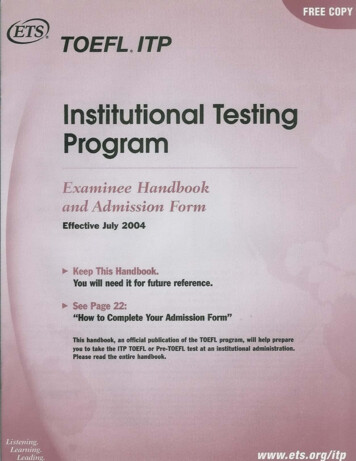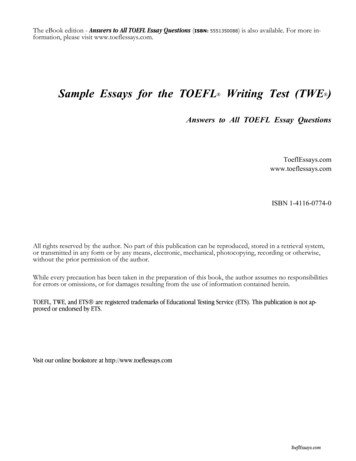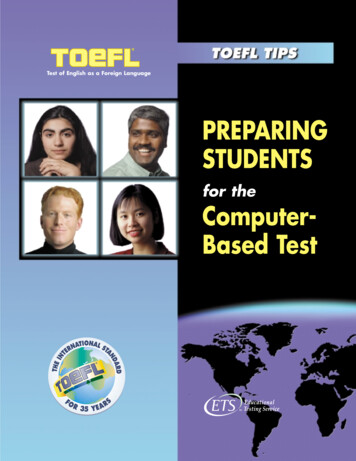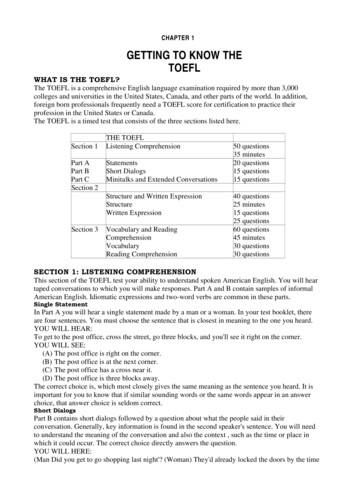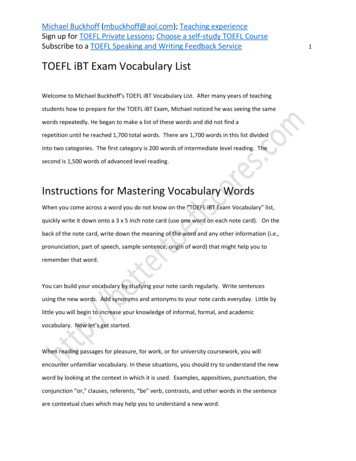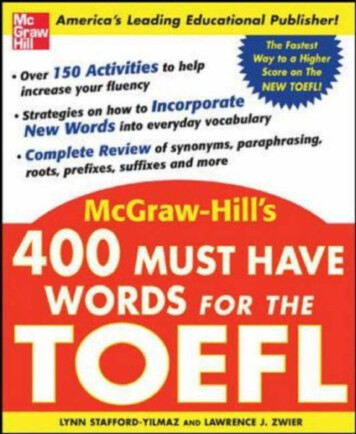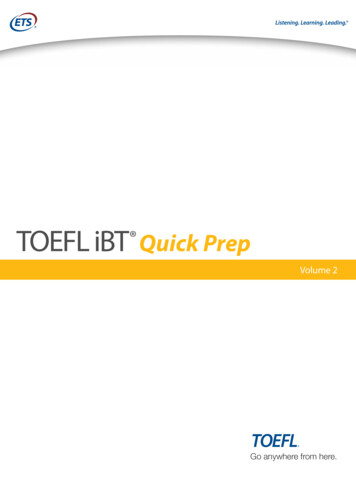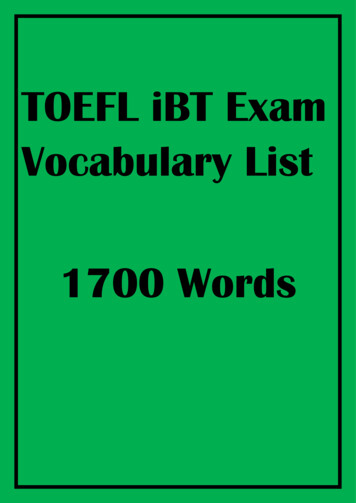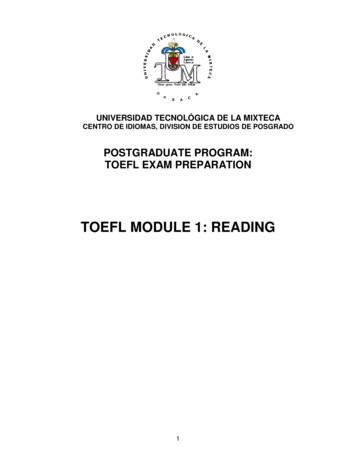
Transcription
UNIVERSIDAD TECNOLÓGICA DE LA MIXTECACENTRO DE IDIOMAS, DIVISION DE ESTUDIOS DE POSGRADOPOSTGRADUATE PROGRAM:TOEFL EXAM PREPARATIONTOEFL MODULE 1: READING1
Postgraduate Program: TOEFL Exam PreparationTOEFL Module 1: ReadingPREREQUISITESAll students taking this course must have completed and passed FCE2, or have scored more than 70points in the Idiomas Placement test.INFORMATION ABOUT THE TEACHERMy name is Maria Pinto. I am in Office 12 in the two-storey Centro de Idiomas building.Email: mariapinto@mixteco.utm.mxWeb page: www.utm.mx/ mariapinto/Lectura.htmlCOURSE INFORMATIONThe TOEFL course consists of two semester-long modules, plus one summer intensive preparationcourse.Module 1 of the TOEFL course is a TOEFL Reading program. It incorporates activities from the paperbased and the Internet-based (iBT) versions of the TOEFL exam.Module 2 of the TOEFL course is a TOEFL Listening program which also incorporates activities fromthe paper-based and the iBT versions of the TOEFL exam. Delivery of this module is subject to theavailability of teaching resources. (In other words: This course will be given when we have the books,CDs, computer setup, and CD-ROMs we need to be able to give the course.)The Summer Intensive module will incorporate activities from the Structure and Written Expressionand the Test of Written English sections of the paper-based TOEFL exam, and Speaking and Writingpractice activities from the Internet-based TOEFL exam. Delivery of this module is subject to theavailability of teaching staff and teaching resources.MODULE 1: READINGThis is a one semester long course. To pass the course, students must: Complete the activities for each week of the course. Take (and pass) the midterm and the Final exam for the courseThere are no face-to-face classes for this course. Students are expected to download the packet ofreadings from Maria’s website, and work through them. Please visit Maria in her office, or send her anemail if you have any questions or need help with the readings.Please make sure Maria has an up-to-date, working email address for you, so that she can contactyou when necessary!EXAM INFORMATIONYou will do a midterm and a final exam for the TOEFL Reading module. Each exam takes two hours.You must do the exam on the dates given below. Students who do not do one or both exams on thedue dates will score a ‘0’ on the module and will fail the course.DateLocationMidterm Exam1 or 2 December 2016 Sala de Auto-acceso, Centro de Idiomas(Ask Angélica for the exam.)Final Exam1 or 2 February 2017Sala de Auto-acceso, Centro de Idiomas(Ask Angélica for the exam.)2
The TOEFL examsThere are two different TOEFL exams; the Internet-based TOEFL (iBT), which is taken by 96% ofstudents around the world, and the paper-based TOEFL, generally given in Mexico.There aresignificant differences between the two exams, summarized in the table below.Paper-based TOEFLInternet-based TOEFLWhat does it test?Tests discrete skills.Direct skill testing.SectionsListeningReadingStructure and Written ExpressionListening(SWE)SpeakingReadingWritingTest of Written English (TWE)(optional)Points677 points120 points(Students usually require 550 points toenter Master or doctoral levelprograms.)Advantages of the Cheaper (usually costs 700 96% of the world does this test.test for UTMpesos). Doing well on the test means thatstudents More places in Oaxaca offer thisyou speak, read, write, and heartest.English well enough to do well instudies abroad. Scores accepted by Mexicanuniversities and by manyAmerican universities. Quicker to prepare for (the examformat has many similarities withthe Cambridge exams) Easier to study for, as studentscan specifically study grammar Mexican students generally haveproblems writing well in English.The written section of this test isoptional, and only offered a coupleof times a year.Disadvantages of Only 4% of the world does this No specific grammar section, sothe test for UTMtest, so it is difficult to get accessstudents must have good generalstudentsto books and practice materials forfluencythe test. Integrated tasks require a highlevel of fluency. Cost: The test costs almost 3000pesos.DIFFERENCES BETWEEN THE PAPER-BASED AND IBT TOEFL READING EXAMSPaper-based55 minutes 5 passages, 50 questionsPassages are shorterInternet-Based60-100 minutes3-5 passages, 12-14 questions on each passagePassages are much longer than with the paperbased test.3
Semester overviewWeekDatesMaterial covered13-7 October 2016TOEFL Paper-based test: 6 October210-14 October 2016Main idea questions317-21 October 2016Main idea and organization424-28 October 2016Directly answered questions531 Oct – 4 Nov 2016Directly and indirectly answered questions67-11 November 2016Indirectly answered questions714-18 November 2016Indirectly answered questions822-25 November 2016Review928 Nov – 2 Dec 2016MIDTERM EXAM: 1 or 2 December105-9 December 2016Vocabulary1112-16 December 2016Vocabulary122-6 January 2017Vocabulary and inferences139-13 January 2017Vocabulary review1416-20 January 2017Overall exam review1523-27 January 2017Reading to learn1631 Jan – 3 Feb 2017FINAL EXAM: 1 or 2 February4Completed?
Table of contentsPrerequisites . 2Information about the teacher . 2Course information . 2Module 1: Reading . 2Exam information . 2The TOEFL exams. 3Differences between the paper-based and iBT TOEFL reading exams . 3Semester overview . 4Table of contents . 5Week 2: Main idea questions . 7(PBT) Answer main idea questions correctly . 7(iBT) Select summary information. 10Week 3: Main idea and organization . 12(PBT) Recognize the organization of ideas. 12(iBT) Insert sentences into the passage . 14Week 4: Directly answered questions . 16(PBT) Answer stated detail questions correctly. 16(iBT) Find factual information. 18Week 5: Direct and indirectly answered questions . 20(PBT) Find pronoun referents . 20(iBT) Recognize referents . 22Week 6: Indirectly answered questions . 24(PBT) Find “unstated” details . 24(iBT) Understand negative facts . 26Week 7: Indirectly answered questions . 28(PBT) Answer implied detail questions correctly . 28(iBT) Make inferences from stated facts . 31Week 8: Review . 33(PBT) Answer transition questions correctly . 33(iBT) Review exercises . 35Week 9: MIDTERM (1-2 December 2016). 37Week 10: Vocabulary . 38(PBT) Find definitions from structural clues . 38(iBT) Understand vocabulary from context. 40Week 11: Vocabulary . 42(PBT) Determine meanings from word parts . 42(PBT) Use context to determine meanings of difficult words . 445
Week 12: Vocabulary and inferences . 46(PBT) Use context to determine meanings of simple words . 46(iBT) Infer rhetorical purpose . 48Week 13: Vocabulary review . 50(iBT) Review exercises . 50Week 14: Overall exam review. 55(PBT) Determine where specific information is found . 55(PBT) Determine the tone, purpose, or course . 57Week 15: Reading to learn. 60(iBT) Complete schematic tables . 60(iBT) Review iBT exam . 62Week 16: FINAL EXAM (1-2 February 2017) . 64Answer key . 656
Week 2: Main idea questions(PBT) ANSWER MAIN IDEA QUESTIONS CORRECTLYMAIN IDEA QUESTIONSHow to identify the questionWhat is the topic of the passage?What is the subject of the passage?What is the main idea of the passage?What is the author’s main point in the passage?With what is the author primarily concerned?Which of the following would be the best title?Where to find the answerThe answer to this type of question can generally be determined by looking atthe first sentence of each paragraph.How to answer the question1. Read the first line of each paragraph.2. Look for a common theme or idea in the first lines.3. Pass your eyes quickly over the rest of the passage to check that youreally have found the topic sentence(s).4. Eliminate any definitely wrong answers and choose the best answer fromthe remaining choices.PASSAGE ONE (QUESTIONS 1-2)Line(5)Fort Knox, Kentucky, is the site of a U.S. army post, but it is even more renowned for theFort Knox Bullion Depository, the massive vault that contains the bulk of the U.S. government'sgold deposits. Completed in 1936, the vault is housed in a two-story building constructed ofgranite, steel, and concrete; the vault itself is made of steel and concrete and has a door thatweighs more than twenty tons. Naturally, the most up-to-date security devices available are inplace at Fort Knox, and the army post nearby provides further protection.1. Which of the following best describes thetopic of the passage?(A) The city of Fort Knox, Kentucky(B) The federal gold depository(C) The U.S. army post at Fort Knox(D) Gold bullion2. Which of the following would be the best titlefor this passage?(A) The Massive Concrete Vault(B) Fort Knox Security(C) Where the U.S. Keeps Its Gold(D) A Visit to Kentucky7
PASSAGE TWO (QUESTIONS 3-4)Line(5)One identifying characteristic of minerals is their relative hardness, which can bedetermined by scratching one mineral with another. In this type of test, a harder mineral canscratch a softer one, but a softer mineral is unable to scratch the harder one. The Mohs'hardness scale is used to rank minerals according to hardness. Ten minerals are listed in thisscale, ranging from talc with a hardness of 1 to diamond with a hardness of 10. On this scale,quartz (number 7) is harder than feldspar (number 6) and is therefore able to scratch it; however,feldspar is unable to make a mark on quartz.3. Which of the following best states thesubject of this passage?(A) The hardness of diamonds(B) Identifying minerals by means of a scratchtest(C) Feldspar on the Mohs' scale(D) Recognizing minerals in their natural state4. The main idea of this passage is that(A) the hardness of a mineral can bedetermined by its ability to make a mark onother minerals(B) diamonds, with a hardness of 10 on theMohs' scale, can scratch all other minerals(C) a softer mineral cannot be scratched by aharder mineral(D) talc is the first mineral listed on the Mohs'scalePASSAGE THREE (QUESTIONS 5-6)Line(5)(10)Hurricanes generally occur in the North Atlantic from May through November, with thepeak of the hurricane season in September; only rarely will they occur from December throughApril in that part of the ocean. The main reason for the occurrence of hurricanes during thisperiod is that the temperature on the water's surface is at its warmest and the humidity of the airis at its highest.Of the tropical storms that occur each year in the North Atlantic, only about five, on theaverage, are powerful enough to be called hurricanes. To be classified as a hurricane, a tropicalstorm must have winds reaching speeds of at least 117 kilometers per hour, but the winds areoften much stronger than that; the winds of intense hurricanes can easily surpass 240 kilometersper hour.5. The passage mainly discusses(A) how many hurricanes occur each year(B) the strength of hurricanes(C) the weather in the North Atlantic(D) hurricanes in one part of the world6. The best title for this passage would be(A) The North Atlantic Ocean(B) Storms of the Northern Atlantic(C) Hurricanes: The Damage and Destruction(D) What Happens from May throughNovember8
PASSAGE FOUR (QUESTIONS 7-9)Para 1234Henry Wadsworth Longfellow (1807-1882) was perhaps the best-known American poetof the nineteenth century. His clear writing style and emphasis on the prevalent values of theperiod made him popular with the general public, if not always with the critics. He wasparticularly recognized for his longer narrative poems Evangeline, The Song of Hiawatha, andThe Courtship of Miles Standish, in which he told stories from American history in terms of thevalues of the time.Evangeline was set during the French and Indian War (1754-1763), when the Britishforced French settlers from Nova Scotia; two lovers, Gabriel and Evangeline, were separatedby the British, and Evangeline devoted her lifetime to the search for Gabriel. With its emphasison sentimental, undying love, Evangeline was immensely popular with the public.In The Song of Hiawatha, Longfellow depicted the noble life of the American Indianthrough the story of the brave Hiawatha and his beloved wife Minehaha. The tear-inspiringpoem follows Hiawatha through the tragedies and triumphs of life, ending with the death ofMinehaha and Hiawatha's departure into the sunset in his canoe.The Courtship of Miles Standish takes place during the early period of the settlement ofNew England, a period which was viewed as a time of honor and romance. In this poemcentered around a love triangle, Miles Standish asks his friend John Alden to propose toPriscilla Mullins for him; John Alden ends up marrying Priscilla Mullins himself, and it takes timefor his friendship with Miles Standish to recover. As with Longfellow's other narrative poems,the emphasis on high ideals and romance made the poem extremely popular.7. Which of the following best describes themain idea of the passage?(A) American history is often depicted in poetry.(B) Longfellow described American historyeven though people really did not enjoy it.(C) The popularity of Longfellow's poemsresults from his stress on the values of thepeople.(D) Longfellow wrote long narrative poems thatwere not always popular with the critics.9. The subject of the fourth paragraph is(A) nobility and honor in the poems ofLongfellow(B) the love triangle involving Miles Standish(C) the popular appeal of The Courtship ofMiles Standish(D) the period of the early settlement of NewEngland8. The best title of the passage is(A) Longfellow's Popular Appeal(B) Historical Narrative Poems(C) The Lyric, Dramatic, and Narrative Poemsof Longfellow(D) Longfellow and the Critics9
(IBT) SELECT SUMMARY INFORMATIONSUMMARY INFORMATION QUESTIONSHow to identify the questionA summary information chart is givenWhere to find the answerBecause the answer demonstrates an understanding of the major points andcritical supporting information, the information needed to answer the questionis found throughout the passage.How to answer the question1. Read the topic stated in the summary chart carefully.2. Read the passage, focusing on the main ideas as they relate to the topicstated in the summary chart.3. Read each answer choice, evaluating whether it is true informationaccording to the passage, false information according to the passage, ornot discussed in the passage.4. Eliminate any answers that are false or not discussed.5. For each statement that is true according to the passage, evaluatewhether it is a major factor related to the topic or is a minor detail.6. Select the answers that are true and are major factors as your responses.7. Partial credit is possible, and your answers may be in any order.PASSAGE FIVE (ISLAND PLANT LIFE)Island plant lifeLine(5)(10)Islands are geographical formations that are completely surrounded by water, yet manyislands are covered with a rich assortment of plant life. It may seem surprising that so muchplant life exists on many islands, yet there are surprisingly simple explanations as to how thevegetation has been able to establish itself there. Some islands were formerly attached to largerbodies of land, while others were created on their own. Islands that were created when floodingor rising water levels cut them off from their neighbors often still have the plant life that they hadbefore they were cut off. In cases where islands formed out of the ocean, they may have plantlife from neighboring lands even though they were never actually attached to the neighboringlands. Winds carry many seeds to islands; some plants produce extremely light seeds that canfloat thousands of feet above the Earth and then drift down to islands where they can sprout anddevelop. Birds also carry seeds to islands; as birds move over open stretches of water, they canserve as the transportation system to spread seeds from place to place.This passage discusses the ways that plant life is able to develop on islands. Answer choices (choose 3 to complete the chart):(1) Some seeds are able to float great distances in the air.(2) Some plant life existed before islands were cut off from larger bodies of land.(3) Some islands have many different varieties of plants.(4) Birds sometimes carry seeds to islands.(5) Some islands were created when rising water cut them off from larger bodies of land.(6) Some plant seeds are carried to islands by the wind.10
PASSAGE SIX (BEN AND JERRY)Ben and JerryLine(5)(10)(15)(20)All successful businesses are not established and run in the same way, with formalbusiness plans, traditional organizational structures, and a strong focus on profits. Ben Cohenand Jerry Greenfield, the entrepreneurs responsible for the highly successful ice cream businessthat bears their names, were businessmen with a rather unconventional approach.They were rather unconventional from the start, not choosing to begin their careers byattending one of the elite business schools, but instead choosing to take a five-dollarcorrespondence course from Pennsylvania State University. They had little financial backing tostart their business, so they had to cut corners wherever they could; the only location they couldafford for the startup of their business was a gas station that they converted to ice creamproduction. Though this start-up was rather unconventional, they were strongly committed tocreating the best ice cream possible, and this commitment to the quality of their producteventually led to considerable success.Even though they became extremely successful, they did not convert to a moreconventional style of doing business. In an era where companies were measured on everypenny of profit that they managed to squeeze out, Ben and Jerry had a strong belief thatbusiness should give back to the community; thus, they donated 7.5 percent of their pretax profitto social causes that they believed in. They also lacked the emphasis on executive salary andbenefits packages that so preoccupy other corporations, opting instead for a five-to-one policy inwhich salary of the employee receiving the highest pay could never be more than five times thesalary of the employee receiving the lowest pay.This passage discusses Ben and Jerry’s unconventional company. Answer choices (choose 3 to complete the chart):(1) They each had a personal commitment to social causes.(2) They began their business with little background and investment.(3) They believed strongly in producing a very high-quality product.(4) They had a salary structure that limits the salaries of high-level executives.(5) They set aside a noteworthy portion of their profits for social causes.(6) They borrowed several thousand dollars from friends to start their business.11
Week 3: Main idea and organization(PBT) RECOGNIZE THE ORGANIZATION OF IDEASORGANIZATION OF IDEASHow to identify the questionHow is the information in the passage organized?How is the information in the second paragraph related to the information inthe first paragraph?Where to find the answerThe answer to this type of question can generally be determined by looking atthe first sentence of the appropriate paragraphs.How to answer the question1. Read the first line of each paragraph.2. Look for words that show the relationship between the paragraphs.3. Choose the answer that best expresses the relationship.PASSAGE ONE (QUESTIONS 1-2)Para 123Conflict within an organization is not always viewed as undesirable. In fact, variousmanagers have widely divergent ideas on the value that conflict can have.According to the traditional view of conflict, conflict is harmful to an organization.Managers with this traditional view of conflict see it as their role in an organization to rid theorganization of any possible sources of conflict.The interactionist view of conflict, on the other hand, holds that conflict can serve animportant function in an organization by reducing complacency among workers and causingpositive changes to occur. Managers who hold an interactionist view of conflict may actuallytake steps to stimulate conflict within the organization.1. How is the information in the passageorganized?(A) The origin of ideas about conflict ispresented. "(B) Contrasting views of conflict are presented.(C) Two theorists discuss the strengths andweaknesses of their views on conflict.(D) Examples of conflict within organizationsare presented.2. What type of information is included in thethird paragraph?(A) A comparison of the interactionist andtraditional views of conflict(B) A discussion of the weaknesses of theinteractionist view of conflict(C) An outline of the type of manager whoprefers the interactionist view of conflict(D) A description of one of the opposing viewsof conflictPASSAGE TWO (QUESTIONS 3-4)Para 123IQ, or lntelligence Quotient, is defined as the ratio of a patron's mental age tochronological age, with the ratio multiplied by 100 to remove the decimal. Chronological age iseasily determined; mental age is generally measured by some kind of standard test and is notso simple to define.In theory, a standardized IQ test is set up to measure an individual's ability to performíntellectual operations such as reasoning and problem solving. These intellectual operationsare considered to represent intelligence.In practice, it has been impossible to arrive at consensus as to which types ofintellectual operations demonstrate intelligence. Furtherrnore, it has been impossible to devisea test without cultural bias, which is to say that any IQ tests so far proposed have been shownto reflect the culture of the test makers. Test takers from that culture would, it follows, scorehigher on such a test than test takers from a different culture with equal intelligence.12
3. What type of information is included in thefirst paragraph?(A) An argument(B) A definition(C) An opinion(D) A theory4. How does the information in the thirdparagraph differ from that in the secondparagraph?(A) It presents a contrasting point of view.(B) It follows chronologically from the ideas inthe second paragraph.(C) It presents real information rather than apremise.(D) lt presents an example of the ideas in thesecond paragraph.PASSAGE THREE (QUESTIONS 5-6)Para 123The largest lake in the western United States is the Great Salt Lake, an inland saltwaterlake in northwestern Utah, just outside the state capital of Salt Lake City. Rivers and streamsfeed into the Great Salt Lake, but none drain out of it; this has a major influence on both thesalt content and the size of the lake.Although the Great Salt Lake is fed by freshwater streams, it is actually saltier than theoceans of the world. The salt comes from the more than two million tons of minerals that flowinto the lake each year from the rivers and creeks that feed it. Sodium and chloride – thecomponents of salt – comprise the large majority of the lake's mineral content.The Great Salt Lake can vary tremendously from its normal size of 1,700 square miles,depending on long-term weather conditions. During periods of heavy rains, the size of the lakecan swell tremendously from the huge amounts of water flowing into the lake from its feederrivers and streams; in 1980 the lake even reached a size of 2,400 square miles. During periodsof dry weather, the size of the lake decreases, sometimes drastically, due to evaporation.5. How is the information in the passageorganized?(A) Two unusual characteristics of the GreatSalt Lake are discussed.(B) Contrasting theories about the Great SaltLake's salt levels are presented.(C) The process by which the Great Salt Lakegets its salt is outlined.(D) The reasons for the variations in the GreatSalt Lake's size are given.6. The third paragraph contains information on(A) how the size of the lake affects weatherconditions(B) the effects of contrasting weatherconditions on the size of the lake(C) the effects of changes in the size of thelake(D) the causes of the varied weather conditionsin the area of the lake13
(IBT) INSERT SENTENCES INTO THE PASSAGEQUESTIONS ABOUT INSERTING INFORMATIONHow to identify the questionLook at the four squares [ ] .Where to find the answerThe places where the sentence may be inserted are marked in the passage.How to answer the question1. Look at the sentence to be inserted for any key words or ideas at thebeginning or the end of the sentence.2. Read the context before and after the insertion squares for any ideas thatrelated to the sentence to be inserted.3. Choose the insertion square that is most related to the sentence to beinserted.PASSAGE FOUR (POPCORN)PopcornPara1A1One method of popping corn involved skewering an ear of corn on a stick androasting it until the kernels popped off the ear. 1B Corn was also popped by first cutting thekernels off the cob, throwing them into a fire, and gathering them as they popped out of the fire.1CIn a final method for popping corn, sand and unpopped kernels of corn were mixed togetherin a cooking pot and heated until the corn popped to the surface of the sand in the pot.22A1DThis traditional Native American dish
The TOEFL exams There are two different TOEFL exams; the Internet-based TOEFL (iBT), which is taken by 96% of students around the world, and the paper-based TOEFL, generally given in Mexico.There are significant difference
